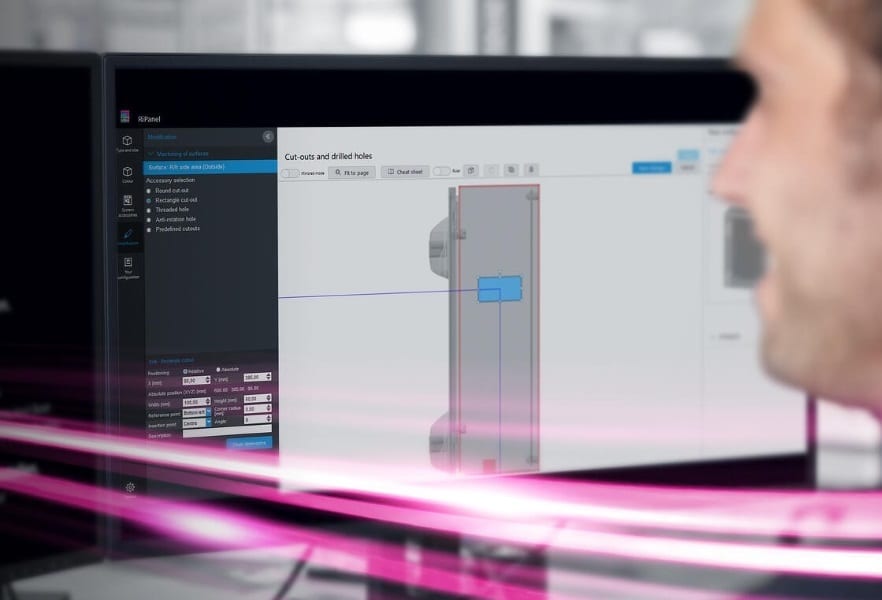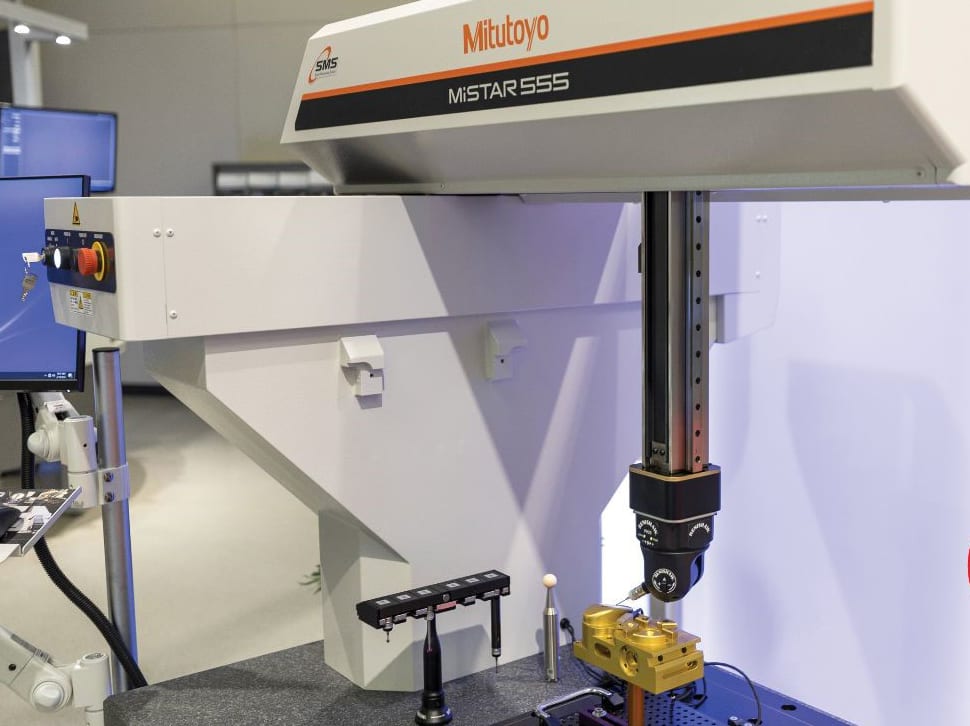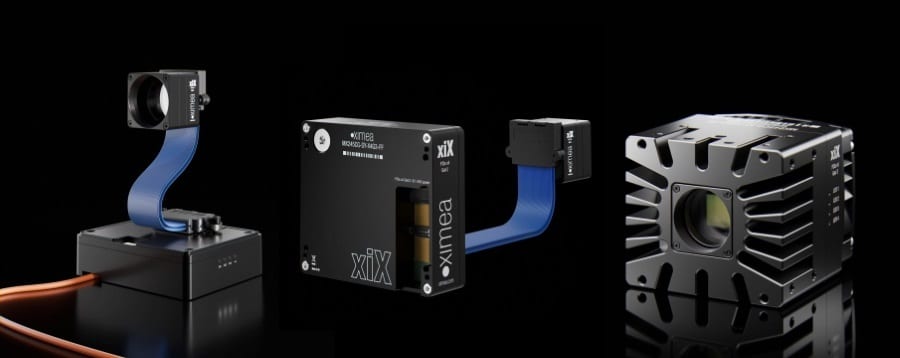Products
the latest products to help you improve your manufacturing process
Rittal RiPanel Online Enclosure Configurator
Rittal North America announces the new RiPanel online enclosure configurator — making it easy for machine and control system design engineers to individually configure industrial enclosures. This saves time, helps to prevent errors, increases flexibility with data saving or exporting, and speeds up processes through integrated interfaces.
Machine and control system design engineers need configurators for individual industrial enclosures to support the customization of complex enclosure system application projects of OEMs, machine builders, and control manufacturers.
Using Rittal’s new RiPanel online enclosure configurator, industrial enclosure systems can be more easily planned in 3D and configured individually. This solution makes it easier to customize enclosures by adding needed accessories or machining requirements.
The new RiPanel online enclosure configuration tool makes it easy for design engineers to individually configure industrial enclosures.
Machine and control system design engineers can now utilize Rittal’s powerful online configurator tool, RiPanel — the operation is simple — with appropriate accessories, plausibility checks to prevent errors, 3D visualization, libraries with predefined drilling patterns, and a direct connection to EPLAN Pro Panel. In addition, engineers can now import and place individual cut-outs on the enclosure, so their customized requirements are easily implemented. RiPanel also provides maximum transparency and consistency throughout the entire engineering and manufacturing processes.
Specific benefits of RiPanel include:
- Saves time due to simple configuration process
- No more errors when selecting accessories or machining options
- Ability to export the configuration’s technical data as CAD and assembly instructions
- Faster processes through integrated interfaces to EPLAN and Rittal software
Rittal North America
https://www.rittal.com

Mitutoyo MiSTAR 555 CNC CMM with PH20 Probe
Mitutoyo America Corporation announced the release of the MiSTAR 555 CMM with the PH20 5-axis probe system. The best Mitutoyo shop floor CMM has enhanced measuring capability, increased feature access, and a threefold improvement of throughput.
Combined with the MiSTAR’s three-side open architecture, wide accuracy-guaranteed temperature range, environment-resistant absolute scale, and all-in-one space-saving design, the MiSTAR performance is set apart from conventional coordinate measuring machines.
Key features:
- Enhanced measuring capability with probe head touches: Rapid head touches – where the CMM is stationary, the head moves to take a measurement point. The rapid rotary motion of the PH20 head allows measurement points to be taken faster and with improved accuracy, repeatability, and dramatic time savings.
- 5-axis provides increased feature access with infinite probe angles: Infinite positioning guarantees optimal feature access, minimizing stylus changes, thereby improving usability over fixed-angled probe heads. 5-axis motion allows larger part access on the CMM by minimizing space required around the part for probe orientation.
- Dramatic reduction in calibration time: The unique ‘inferred calibration' technique developed for PH20 determines the head orientation and probe position in a single operation, allowing subsequent measurement at any head angle. Further modules only require a few touches on the calibration sphere before use.
- Compatible with the existing range of TP20 modules: Users of the PH20 probe head will immediately have access to the range of proven TP20 probe modules, providing a wide selection of trigger forces, directional sensing options and extensions to meet application requirements. The detachable modules provide crash protection and can be automatically changed using the TCR20 change rack. The TP20 EM2 probe module allows holes greater than 300 mm diameter to be measured without CMM motion.
Mitutoyo America
https://www.mitutoyo.com/literature/mistar-555-ph20/

Teledyne FLIR Neutrino SX12 ISR1200 MWIR Camera
Teledyne FLIR, part of Teledyne Technologies Incorporated, introduced the Neutrino SX12 ISR1200, the first model in the new Neutrino Ground ISR series of high-performance, MWIR camera modules with integrated CZ optics. The HD MWIR system combines a Teledyne FLIR MWIR camera module and 120mm to 1,200mm CZ optics with industry-adopted imaging electronics from InVeo Designs LLC to provide a best-in-class ISR solution with low-switching-cost for defense and industrial integrators.
Based on Teledyne FLIR focal plane array (FPA) technology, near diffraction-limited optics, and a long-life linear Stirling cooler with 25,000-hour MTTF, the Neutrino SX12 ISR1200 offers 1280x1024 resolution with 12µm pixel size. It also features dual-parallel outputs using a 60Hz Camera Link base with 1080P30 HD-SDI or 720P60 HD-SDI, ideal for tracking, turbulence mitigation, and artificial intelligence. The SX12 ISR1200 is a turnkey system that is ideal for integration with ground-based, long-range ISR, perimeter surveillance, border surveillance, and counter-unmanned aircraft systems (C-UAS).
The long focal length CZ lens was developed and is produced by the Teledyne FLIR team, formerly of New England Optical Systems (NEOS), which joined FLIR in 2019. The system provides autofocus, focus, and boresight retention through zoom, and it is factory optimized for each integrated system. The lens, the MWIR camera module, and imaging electronics are all designed and manufactured in the United States.
Teledyne FLIR
www.teledyneflir.com/neutrino

XIMEA Sony CMOS Pregius S Camera Models
XIMEA has announced new full speed models with exceptional Sony CMOS Pregius™ S sensors. Outstanding properties of the next evolution of Sony CMOS sensors include the small pixel size in combination with BSI - backside illumination technology. Small pixels mean that sensors with a high resolution of 24.5 Mpix can stay very compact contributing to closer proximity for multi-camera setups.
The backside illumination compensates for the small pixel and even improves the standard parameters, offering low noise, high dynamic range, and sensitivity. The new technology outperforms the low-noise values of CCD sensors at the same time providing high-speed bandwidth with a Global shutter. The pixel size of 2.74 µm helps to use C-mount lenses thus improving the cost-effectivity and enabling miniature size for mobile and multiple camera systems.
To leverage the tiny size of Sony sensors, XIMEA has integrated them into the smallest form factor where the camera head measures only 26 x 26 x 33 mm. The camera head is wrapped into innovative housing where the sensor part can be detached while the camera body enhances the speed through 32 Gbit/s.
Typically, the camera size depends and is limited by the surface of the largest integrated printed circuit board (PCB) and its components. XIMEA has developed a solution how to split the camera into separate pieces, isolating the PCBs and connecting them via a flat flexible ribbon cable. This approach is unique especially in the case of high-speed cameras as it allows minimizing the sensor footprint distancing it from the main body by up to 3 meters.
The super-fast speed of 32 Gbit/s data throughput is able to ensure 16 Mpix at 150 Fps, 20 Mpix at 110 Fps, and 24 Mpix at 105 Fps.
In addition to all mentioned, among the new features is the Dual ADC of low and high gain modes, the fusion of which as a result produces HDR images. The processing of Dual ADC is done on the sensor side, plus XIMEA added the off-sensor FPGA merging that results in the linear response curve. Besides other features, the present is also the ultra-short interval between two shutters (interframe time), important for PIV applications - Particle image velocimetry.
As a bonus, the models can be implemented with exposure time monitoring and an improved on-sensor thermometer.
XIMEA

Hitachi High-Tech FT230
Hitachi High-Tech Analytical Science has expanded its plating and coatings analysis range with the launch of the breakaway FT230. The new FT230 is designed to enable quality control to keep pace with production by significantly simplifying and accelerating testing of components and assemblies. Removing the traditional hurdles of XRF analysis, the FT230 speeds up analysis and reduces costly errors to help electronics and component-level manufacturers, general metal finishers and plating-on-plastic facilities achieve 100% inspection and meet tightening specifications.
Every aspect of the FT230 was designed to reduce the amount of time it takes to complete an XRF measurement. With traditional XRF instruments, around 72% of testing time is lost on set up, meaning that operators spend significantly more time preparing a measurement and manipulating the results than the instrument spends analyzing the part. The user experience (UX) of the FT230 is significantly improved by an intelligent part recognition feature called Find My Part™ that automatically selects the features that need to be measured, the analytical routines and reporting rules so the operator spends less time using the XRF and more time working the results. The on-board, user-built library is easily expanded to handle new parts and new routines as your work changes.
The FT230 is the first product running Hitachi’s all new FT Connect software, carrying the best aspects of its established SmartLink and X-ray Station software and adding new functionality ready to improve usability. FT Connect completely inverts the traditional interface. Whereas with traditional software, most of the screen is occupied by controls – many of which are used infrequently, if at all, FT Connect focuses the interface on the most important aspects of the XRF. The real estate is dominated by the large sample view and clear results presentation, making it easier to position parts for analysis and see the results.
You can instantly get results to where you need them with FT Connect’s flexible data handling features. Results are prominently displayed in the main measurement screen so operators can take action quickly, and stored on-board for later reviews. The results can be exported in spreadsheet or comprehensive JSON format for integration with SCADA, QMS, MES or ERP systems. Customized reports can similarly be created for internal or external customers.
In addition to a series of functions to confirm instrument stability (including routine instrument checks and calibration validation tools), the on-board diagnostics give users further information about the health of the instrument. This data can be shared directly with Hitachi’s technical support team over ExTOPE Connect (Hitachi’s cloud-based advanced data management and storage service that allows you to share data instantly and securely).
The FT230 adds value beyond measuring plating and coating thickness and composition. The powerful software and high-resolution SDD makes it possible to screen parts for conformity to restricted materials legislations such as RoHS and analyze the composition of materials including plating bath solutions and metal alloys, useful for validating incoming substrates and confirming chemistry, which is crucial for hallmarking centers handling precious metals.
From simple plating and coatings to sophisticated applications on the smallest features, Hitachi High-Tech’s extensive range of analyzers – now including the FT230 – is designed to confidently measure coated parts throughout production, from incoming inspection, process control through final quality control.
Hitachi High-Tech Analytical Science
www.hitachi-hightech.com/hha

Evident SZX-AR1 Augmented Reality System
The SZX-AR1 augmented reality system easily retrofits to existing Olympus SZX series stereo microscopes to simplify complex microscope-based manufacturing tasks and simplify assembler training. Manuals, assembly instructions, images and instructional videos can be projected in the microscope’s field of view so that assemblers can work more efficiently.
The microscope-based assembly process can require the assembler to stop multiple times to consult instructions or to memorize these instructions before beginning their work. Repeatedly removing ones’ eyes from the microscope oculars is inefficient and memorizing directions can lead to mistakes.
The SZX-AR1 unit solves these challenges by enabling instructions to be projected directly in the microscope’s field of view. Now, an assembler can complete their work without removing their eyes from the oculars or tediously memorizing complex sets of directions.
If there’s a problem during the manufacturing process, an assembler can use third-party collaboration software, like Microsoft Teams, to share a live view through their oculars with an offsite manager or engineer for guidance. The AR1 unit’s image and video recording capabilities make documenting any issues fast and simple.
Rather than relying on an onsite trainer to painstakingly instruct new employees about each step of the assembly process, the AR1 system enables users to receive training while they’re looking through their microscope’s oculars, helping them stay focused and making the process faster and more efficient.
Using the AR1 system, the trainer and trainee no longer need to be in the same place, eliminating travel costs. Manufacturers also have the option of using video recordings to train new employees rather than using a live trainer as the instructions can be projected directly on the sample through the microscope’s field of view.
Evident
www.EvidentScientific.com
